#dusky seaside sparrow
Text
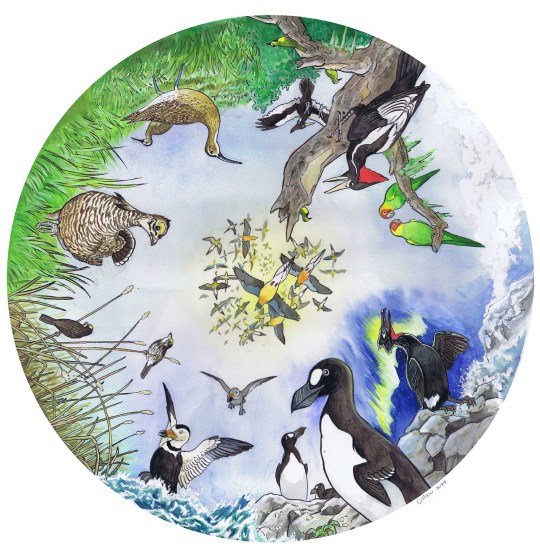
Lost Americans wheel. Watercolor and ink.
#extinct#extinct bird#great auk#carolina parakeet#passenger pigeon#eskimo curlew#labrador duck#ivory billed woodpecker#bachman's warbler#heath hen#dusky seaside sparrow#spectacled cormorant
795 notes
·
View notes
Text


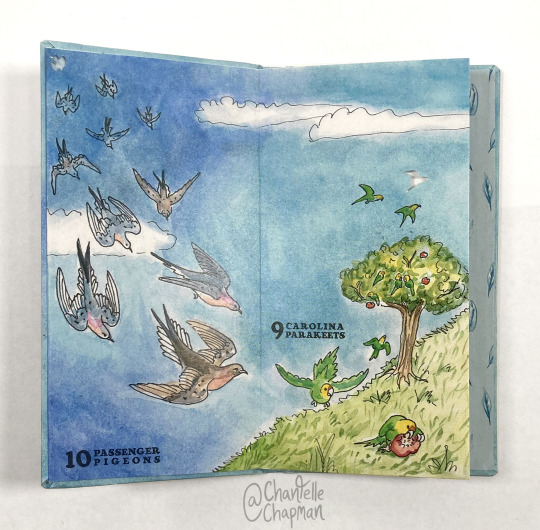
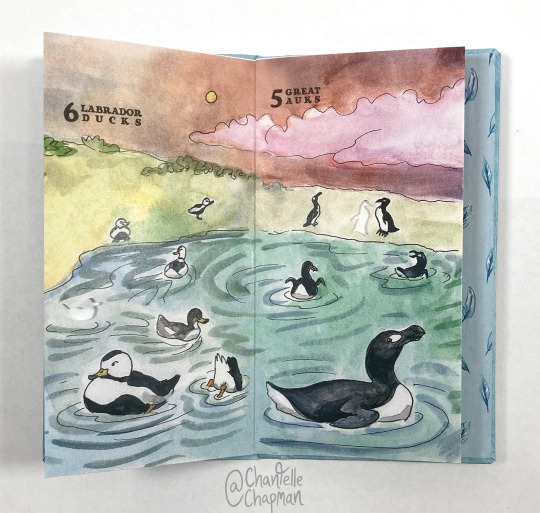


And Then There Were... a miniature counting book that I illustrated and bound by hand. The book is 5 1/2 x 3 inches, and features the extinct Passenger Pigeon, Carolina Parakeet, Heath Hen, Eskimo Curlew, Labrador Duck, Great Auk, Dusky Seaside Sparrow, Bachman's Warbler, Ivory Billed Woodpecker, and Kauai ʻōʻō. Illustrated in traditional pen & ink and watercolor. Like Grasping at Feathers, this book also includes cut-out elements. The concertina-style pages fold out to form one continuous spread. Created as an edition of 5, but I have plans to do another larger run.
#extinct birds#recently extinct#bookarts#passenger pigeon#carolina parakeet#heath hen#eskimo curlew#great auk#dusky seaside sparrow#bachman's warbler#ivory billed woodpecker#kauai o'o#o'o
274 notes
·
View notes
Photo

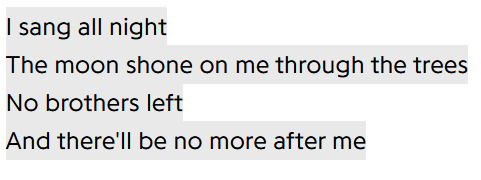



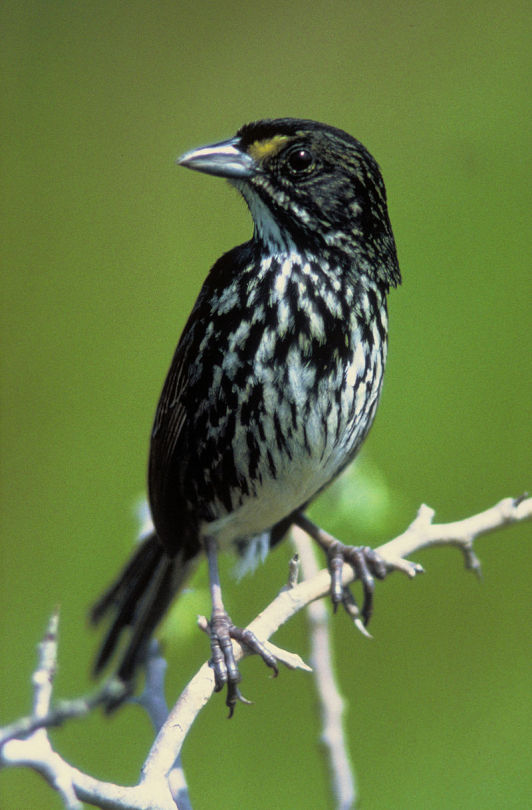
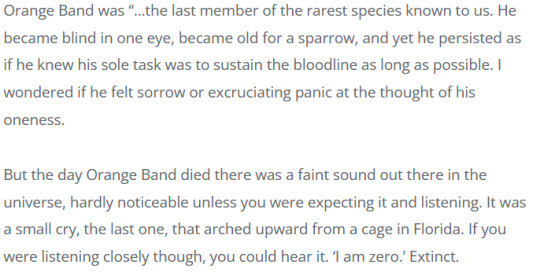
An endling is the last known individual of a species or subspecies. Once the endling dies, the species becomes extinct. (Wikipedia)
Sara Burnett, “Endling” / The Mountain Goats - Deuteronomy 2:10 / Andrew Del-Colle, “Ivory-billed Woodpecker to Be Officially Declared Extinct in U.S.” / Cosmo Sheldrake - Pliocene / Hannah Seo, “Extinction obituary: the sudden, sad disappearance of the Christmas Island forest skink” / Wikipedia, Dusky seaside sparrow / Robert James Waller, “Old songs in a New Cafe”
4K notes
·
View notes
Audio
The song of the now-extinct dusky seaside sparrow.
Taken from the audio cassette tape “Sounds of Florida’s Birds (1998)” by J.W. Hardy, curator emeritus in ornithology and bioacoustics at the Florida Museum of Natural History. [ x ]
1K notes
·
View notes
Text
Round 1, Poll 7
Gray Vireo vs Dusky Seaside Sparrow


sources under cut
Gray Vireo Propaganda:
Noted as being one of the most plain looking birds in North America, Gray Vireo live in the Southwest in various scrublands: pinyon-juniper, mesquite, and oak.
Like other vireos, they will use the slight hook in their bill to help tear apart the insects they capture, typically beating them against branches before holding down the bug and ripping into it. Also like other vireos, they sometimes sing while sitting on their nest!
They're monogamous throughout the breeding season, with males singing consistantly from dawn til noon and running circles around their territory multiple times per day. Sometimes on these rounds, the female will wander with him, only singing if there is a territorial conflict with another pair. Both male and female will incubate eggs, and feed the young.
(this is my current focal species for work I promise I'm not biased, they're just perfect in every way)
Dusky Seaside Sparrow:
"extinct; RIP little guy :(" - declared officially extinct in December 1990
A subspecies of the Seaside Sparrow, this specific type was found in saltmarshes of Florida's Atlantic Coast on Merritt Island and the upper St. Johns River.
The main cause for extinction is likely linked to mosquito control measures: DDT use, the creature of "mosquito impoundments" that destroyed saltmarsh habitat, and finally the flooding of the marshes on Merritt Island after the Kennedy Space Center was built. Another huge blow was when the marshes were drained to facilitate highway construction.
As a species, Seaside Sparrows are incredible habitat specialists that remain in saltmarshes and brackish marshes their entire life. They nest in the tall grass of riverbanks, creating an orb-shaped nests just high enough from the water to keep from flooding daily. Once the chicks have fledged and been cared for by their parents, they will often form small flocks in order to forage together.
Image Source: All About Birds
#hipster bird main bracket#round 1#polls#gray vireo#seaside sparrow#dusky seaside sparrow#listen if gray vireo lose I'll be sad but I love Duskies too#bracket: fave a
28 notes
·
View notes
Text
1987-Dusky seaside sparrow

With the death of the last individual of the species, the dusky seaside sparrow becomes extinct.
12 notes
·
View notes
Text
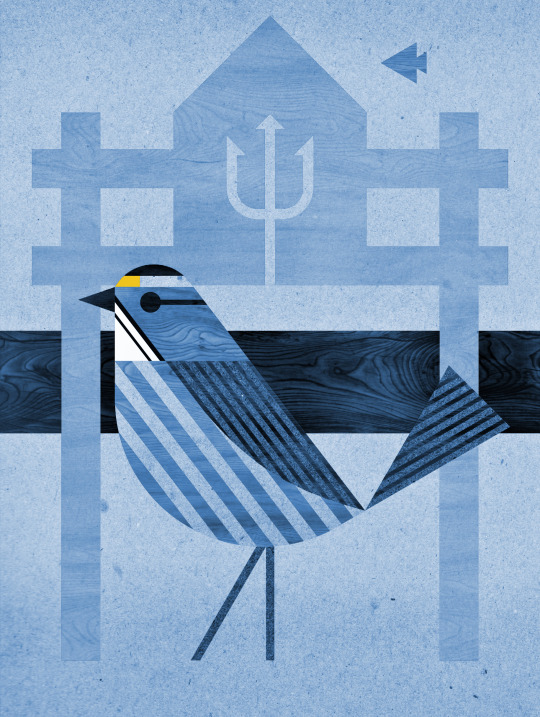
The Seaside Sparrow, Ammodramus maritimus, under the pier at Virginia Beach.
403 notes
·
View notes
Text
there’s nothing sadder than reading an entire species of animals ‘was’
1 note
·
View note
Text
uh-oh now i’m reading poetry and crying
#maybe i should incorporate a dusky seaside sparrow into the design of my future science tattoo#it may never be as famous as the pterodactyl or the dodo but the last one died today
3 notes
·
View notes
Text
thinking about extinct birds so much
thinking about the passenger pigeon, martha, and carolina parakeet, inca, the last presumed members of their species dying only a few years apart in the same enclosure at cincinnati zoo
thinking about the last kauaʻi ʻōʻō, calling out their part of a duet with no one left to return it
thinking of the last breeding pair of great auks, who were killed by fisherman. clumsy on land, they ran to the sea to escape. their carcasses were sold on the mainland, and their single egg accidentally crushed underfoot in the chase
thinking of the last heath hen, booming ben, last seen on his lekking grounds, standing alone with no one to display to or compete with
thinking of the last dusky seaside sparrow, orange band, dying alone of old age on a nature preserve
thinking of all the birds that went quietly, without us noticing.
624 notes
·
View notes
Text
slides band around your shoulder. did you know that disney’s stupid ass abandoned discovery island park is the reason for the extinction of the dusky seaside sparrow, a subspecies of the seaside sparrow
11 notes
·
View notes
Text

The Dusky Seaside Sparrow (Ammodramus maritimus nigrescens)
became extinct this day in 1987.
15 notes
·
View notes
Text
Given the wretchedly low quality of mass produced content on YouTube, the less frequent but high quality stuff does pose a risk to YouTube.
An entrepreneur, or a group of wise investors, could entice a vast cadre of the finest creators away from YouTube to a space where they could have better resources, better pay and benes, and a more mature forum.
Leave the riffraff on YouTube until it goes the way of the dusky seaside sparrow.
0 notes
Photo

In this Walt Disney World brochure about the now-defunct Discovery Island, three images of dusky seaside sparrows can be seen in the bottom right corner. The last known birds, four males, spent their twilight years at the park, with the last member of the small flock passing away in June of 1987. [ x ]
28 notes
·
View notes
Text
Efforts to Save North America’s Most Endangered Bird Are Succeeding
New Post has been published on https://petnews2day.com/birds-news/efforts-to-save-north-americas-most-endangered-bird-are-succeeding/
Efforts to Save North America’s Most Endangered Bird Are Succeeding
On June 1, a tiny Florida Grasshopper Sparrow scurried out of an outdoor aviary and onto conservation lands south of Orlando, joining a fragile but recovering population of the most endangered birds on the continent. Unbeknownst to the little brown bird, it was the 501st captive-bred Florida Grasshopper Sparrow to be released as part of a concerted breeding effort.
By 2017, the total population of the imperiled Florida Grasshopper Sparrow had fallen below 100, prompting federal, local, and private organizations to initiate a conservation breeding program that has since found surprising success. Today, about 15 captive breeding pairs lay eggs and raise young in carefully maintained outdoor enclosures at various locations. In 2019, the first batch of captive-bred offspring were released to help rebuild the wild population, which as of 2021 had rebounded to roughly 125 birds from a low of fewer than 30 breeding pairs in 2018.
“It’s exceeded all of our wildest expectations,” Julie Wraithmell, executive director of Audubon Florida, says of the program. “They’ve bred well in captivity, and they’ve survived on the prairie and gone on to breed on the prairie.”
Key to the program’s early success has been the close collaboration among a variety of organizations, including the U.S. Fish and Wildlife Service (FWS), the Florida Fish and Wildlife Commission (FWC), Fish and Wildlife Foundation of Florida, White Oak Conservation, the Avian Preservation and Education Conservancy, and Audubon Florida. By sharing breeding strategies, triumphs, and failures, the group has been able to halt the sparrow’s slide toward extinction.
Despite this monumental achievement, however, all of the partners are careful to note that these measures should be considered a last resort. “This conservation breeding program buys us time to continue to do research, to try to understand what are the causes of the decline,” says Juan Oteyza, an FWC biologist who helped spearhead the effort.
As comfortable on the ground as it is in the air, the Florida Grasshopper Sparrow is an orange-cheeked bird with the habits of a mouse and the buzzy voice of a bug. A subspecies of the more widespread Grasshopper Sparrow, the secretive birds live solely in central Florida’s grasslands. In the 1990s and 2000s, after decades of gradual decline due to habitat loss—more than 90 percent of Florida dry prairie has been destroyed—Florida Grasshopper Sparrow populations mysteriously began to collapse.
With numbers cratering, desperate conservationists scrambled to create a captive breeding program to help save the birds. The 1987 extinction of Florida’s Dusky Seaside Sparrow was still fresh in their minds: By the time breeding programs were attempted for that subspecies, it was too late—there weren’t enough birds left.
No one wanted to repeat the same mistake with the Florida Grasshopper Sparrow. “That has always been in the back of our minds: Don’t wait too long,” says Mary Peterson, an endangered species recovery biologist with FWS. But that didn’t make the decision to capture some of the few remaining sparrows any easier.
Fortunately, the sparrows adapted well to captivity—much better than anyone had expected.
“Nobody wants to see a wild bird put in a cage,” Peterson says. “We just knew that if we didn’t do something that the population was headed to extinction.”
Fortunately, the sparrows adapted well to captivity—much better than anyone had expected. Protected and with plenty of food, the birds thrived, with some producing multiple broods in a season. Concerns over how the captive-bred chicks would adapt to wild habitat upon release were also quickly quelled; their genetic hardwiring kicked in, and they were able to forage, sing, and breed without issue.
“We were not sure if they were going to be able to even survive,” says Adrienne Fitzwilliam, avian conservation coordinator at FWC. “They not only survived, but they also started breeding, and this helped grow the overall numbers of birds in the wild population.”
According to Oteyza, roughly 30 percent of the captive-bred birds have been found to remain at the release site. And up to 20 percent are breeding—impressive numbers for any songbird breeding program, he says.
Oteyza credits the coalition’s strategy of balancing habitat management, nest protection, field research, and outreach to private landowners for much of the program’s success. “What we have used for Florida Grasshopper Sparrow is this multi-pronged approach—not just putting all our eggs in one basket, if you will,” he says.
vimeo
Video: Katie Bryden/Wildpath
With the population stabilized and heading in the right direction, determining the root cause of the Florida Grasshopper Sparrow’s decline is a priority for the program. Researchers have studied factors like predation, flooding, fire, genetics, and land management, but the exact cause remains unclear. Still, the partners have made discoveries that will further aid the program and also inform efforts to save other endangered birds.
Though many questions and challenges remain, the program’s success has given conservationists cause for cautious optimism. “The first time you capture a wild bird and put it into captivity is heart-wrenching,” Peterson says. “But then when you see these birds returning to the prairie, it makes it worth it.”
Source link
0 notes
Text
Round 2, Poll 4
Dusky Seaside Sparrow vs Yellow-billed Magpie


sources under cut
Dusky Seaside Sparrow
"extinct; RIP little guy :(" - declared officially extinct in December 1990
A subspecies of the Seaside Sparrow, this specific type was found in saltmarshes of Florida's Atlantic Coast on Merritt Island and the upper St. Johns River.
The main cause for extinction is likely linked to mosquito control measures: DDT use, the creature of "mosquito impoundments" that destroyed saltmarsh habitat, and finally the flooding of the marshes on Merritt Island after the Kennedy Space Center was built. Another huge blow was when the marshes were drained to facilitate highway construction.
As a species, Seaside Sparrows are incredible habitat specialists that remain in saltmarshes and brackish marshes their entire life. They nest in the tall grass of riverbanks, creating an orb-shaped nests just high enough from the water to keep from flooding daily. Once the chicks have fledged and been cared for by their parents, they will often form small flocks in order to forage together.
Yellow-billed Magpie
"Growing up, magpies were just another bird. Pretty, but loud and kind of annoying. Just this year (in my 30s!), I learned that the Yellow-billed Magpie only lives in the central valley and on the central coast of California. These birds were so common that I had no idea they only lived here. Very few people in my region seem to know that either so I've been spreading the knowledge."
They've got quite a varied diet, as most corvids do. Insects and scavenged carcasses make up a chunk of their food, but these magpie will also eat acorns, nuts, fruit and grains. They have been seen flipping over dried cow manure to pick at the insects living underneath, and will sometimes pluck ticks off of deer and horses.
Yellow-billed magpie will nest in loose colonies, and prefer to place their nests in clumps of mistletoe. They're at risk of losing a lot of habitat as the Central Valley becomes more and more developed, which lands this species on IUCN's Vulnerable list.
#hipster bird main bracket#polls#round 2#bracket: fave a#dusky seaside sparrow#yellow billed magpie#corvidae#passerellidae
9 notes
·
View notes